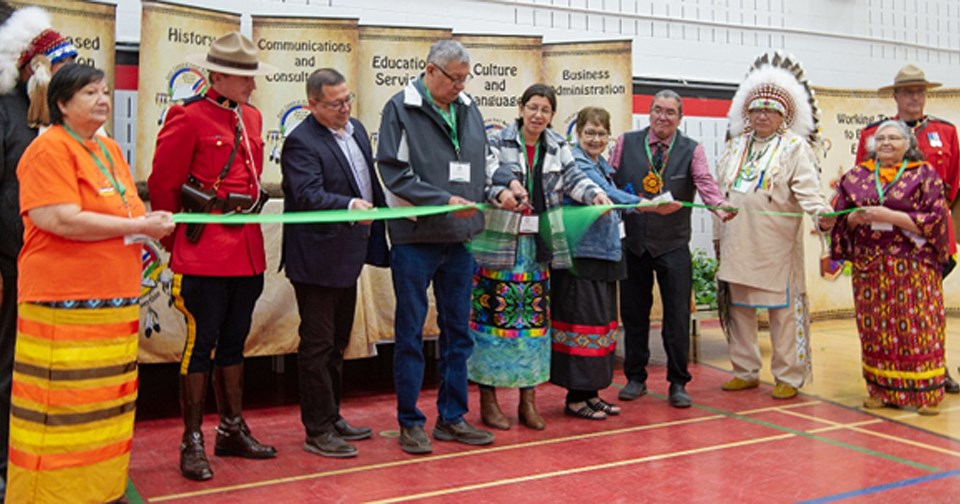JAMES SMITH CREE NATION – The East Central First Nation Education Authority had their official grand opening with a large crowd.
Director of Education for the ECFNEP, Randy Constant, said since its incorporation, the partnership has made a positive impression on all stakeholders. The partnership has come a long way since its inception, resulting in many positive changes for the school and community.
Constant said, “I am pleased with the progress that has been made through the many open houses, the meetings with leadership and with the Education Working Group Table which has established the roles, responsibilities, policies and procedures that go into the day-to-day operations. Oversight has been provided into how various programs play out for the different demographics of the school.”
The Bernard Constant School held a powwow to mark the ribbon cutting. There were 11 drum groups that performed at the Pow Wow, and there were more than 300 dancers. The day started with a pipe 小蓝视频 and had several dignitaries in attendance: Mervin Whitehead, vice-principal of Bernard Constant Community School; Codi Baptiste, BCCS's principal; Randy Constant, director of education; Camillia Sanderson, chairperson of the ECFNEP board of directors; Merv Morin, Regional Director of Programs, Indigenous Services, Canada; Chakastaypasin Band Chief Calvin Sanderson; Peter Chapman Band Chief Robert Head and James Smith Cree Nation Chief Kirby Constant.
The ribbon cutting 小蓝视频 was performed by Chairperson Sanderson and Elder Peter Sanderson.
Constant said one of the major successes was the signing of the Education Services Agreements with nearby school divisions, the North East School Division (NESD) and the Saskatchewan Rivers Public School Division (SRPSD). The Education Services Agreements provided direction for the organization to fulfill its responsibilities to the First Nations and other partners, Constant said.
ECFNEP collaborated with the two surrounding school divisions, North East School Division and Saskatchewan Rivers Public School Division, said Constant, and they will work on a framework that will outline the financial obligations of those students living within those jurisdictions and attending each other’s education systems.
Constant thinks these agreements will help bring the school divisions together and create an easy method of collaboration between them for resolving issues and sharing information.
The agreements have brought with them a sense of cooperation and recognition, with Constant saying, “Since establishing ourselves as an organization, we are now able to reap the benefits of all the hard work that went into the creation of ECFNEP today, because of all the work that we’ve done at the provincial and national levels.”
Constant commented on the process of the agreement, saying, “They have the addition and creation of the Wellness Centre within the school, things like the Practical and Applied Arts expansion, with the Aesthetics, Kitchen and Shop Programs, along with the acquisition of various implements that assist the maintenance crew who perform the important task of the upkeep and care of the grounds. Another big change is the education for the High School Program transitioning to eight block classrooms with two traditional semester courses, which provides programming for the high school experience.”
Constant said, “Support among the community, the parents and students seem to be at a high level, with the amount of student enrolment increasing solidly each year.” Constant is pleased with this growth, saying, “Enrolment continues to grow year by year, which may indicate the need for a building that would house the high school program.”
The increased enrolment shows that the parents fully support the partnership model that has been developed and support from the leadership is another positive aspect Constant said.
“The support that the partnership has received from leadership has been remarkable. They’ve allowed us to explore current research best practices and to make changes if things were not working. We are grateful for their insight at the Education Working Group Table which goes into strategic planning, policy, and procedures.”
Along with the high rate of enrollment is the steady rate of graduation, with Grade 12 students consistently coming out of the program year after year and moving on to post-secondary and workforce opportunities. The East Central First Nations Education Partnership is a grand undertaking, said Constant, and none of its many successes would have been possible without an excellent team of staff.
Constant recognizes this and expressed his thanks, saying, “The staff at Bernard Constant Community School (BCCS) have shown patience, resilience and commitment throughout the entire process and continue to benefit from the programs, services and supports that ECFNEP provides every day."
Constant said he hoped the grand opening of the organization would be a day to celebrate for all partners at all levels, for parents and students, for other members of the community and of course, the staff of the school and the partnership.
The East Central First Nations Education Partnership Board of Directors has six members, two from each of the three First Nations participating in the partnership. The chairperson of the board is Camillia Sanderson representing the Chakastaypasin Band, Phyllis Head is the vice-chairperson representing the Peter Chapman Band, Devin Head is the secretary-treasurer, Janel Kinch is the secretary representing the Chakastaypasin Band, Lillian Burns and Margaret Daniels are members representing the James Smith Cree Nation.




